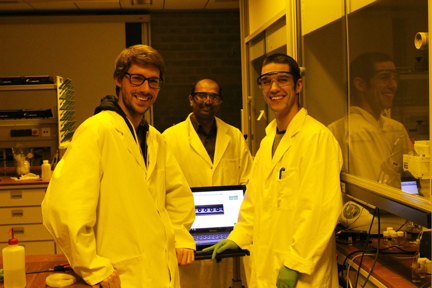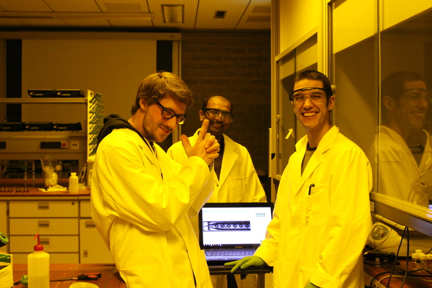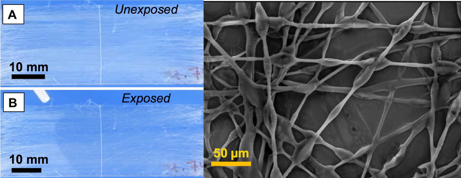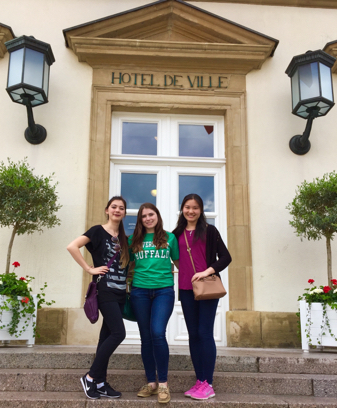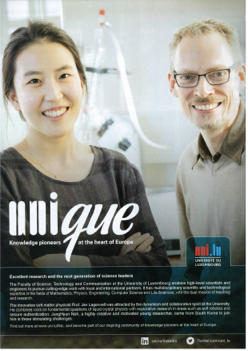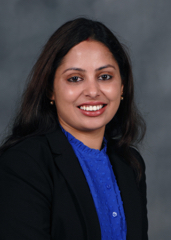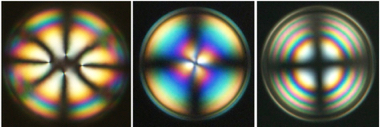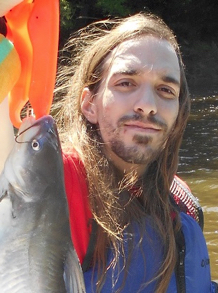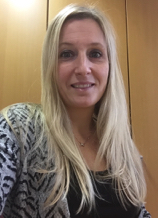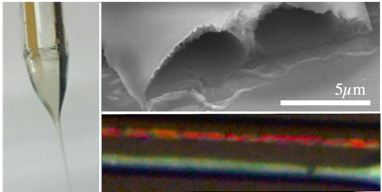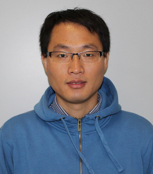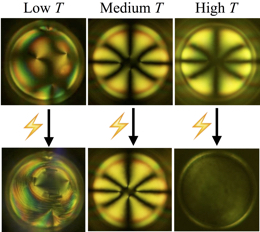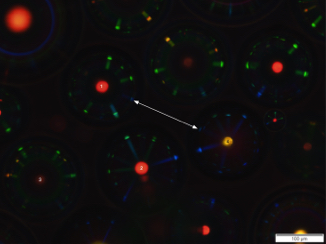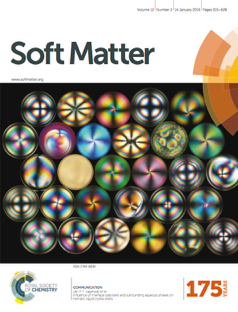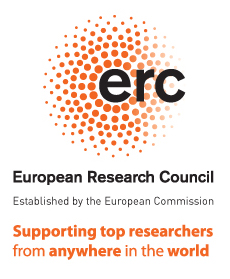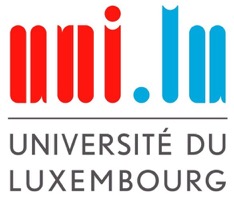03/11/16 15:32
We have the pleasure of hosting Dirk Jan Mulder, Ph.D. candidate in the group of
Prof. Albert Schenning, Technical University of Eindhoven, during November. Dirk Jan is working on microfluidic liquid crystal elastomer shell production together with Rao and Kevin (see action pictures from the yellow lab), and also on porous shell production together with JungHyun.
Tags: visitors
30/09/16 14:11
Congratulations to JungHyun and Benjamin for their new
Adv. Mater. paper "
Taming Liquid Crystal Self-Assembly: The Multifaceted Response of Nematic and Smectic Shells to Polymerization" on polymer-stabilization of nematic and smectic liquid crystal shells, and the sometimes unexpected consequences for the liquid crystal self-assembly. By polymerizing a small fraction of the reactive mesogen RM257 in shells of 8CB or its homologues, certain defect configurations can be locked in place, the exact result depending sensitively on the mixture composition and the temperature at which polymerization is carried out. Surprisingly, when polymerizing close to a phase boundary, a transition into the adjacent phase can be induced. The new phase can be more or less ordered, depending on the starting situation. The lifetime of the shells is dramatically enhanced, as is the temperature stability. By tuning the conditions, the self-assembled structure can be made fully permanent, being visible even upon heating to the isotropic phase of the non-polymerized component, or it can be retained in a latent state, allowing macroscopic loss of order on heating to the isotropic phase yet with a memory of the chosen defect configuration when cooling down. Apart from proposing explanations for the various observations we discuss possibilities to apply the polymer-stabilized shells, for instance in advanced materials generation or in sensing.
Here you can find the full paper (don't forget to check out the rich supporting information, including many spectactular movies), and here is a layman's abstract for the paper.
Tags: publications
06/08/16 23:20
Congrats to Catherine and Anshul, whose paper on non-electronic toluene vapor sensing using electrospun PVP fibers filled with nematic 5CB liquid crystal is now
available (Open Access) from the
Liquid Crystals website. In the article they demonstrate that there are two types of response to toluene vapor exposure, one slow and one fast. The slow one corresponds to a toluene diffusion-induced clearing transition, whereas the fast one is connected to a change in liquid crystal director field configuration, but the 5CB remains in the nematic phase. This fast response is seen across the mat within a fraction of a second, even several centimeters away from the exposure point, indicating that the detection threshold is very low. They also show that the responses of uniformly cylindrical fibers and beaded fibers are quite different, the latter allowing detection by the naked eye, without polarizers.
Download the paper (no subscription needed) here.
Tags: publications
07/06/16 07:08
We are glad to welcome Vianna Chan, Michelle Park and Laura Saunders to our group! They constitute the fourth round of visitors within the NSF-funded IRES (International Research Experience for Students) project led by our collaborator Prof. Antal Jakli at Kent State University, Kent (OH), USA. Michelle (left), Laura (middle) and Vianna (right) will be working with electrospinning and electrospray of fibers/beads with liquid crystal core.
Tags: visitors
30/05/16 10:30
Congrats to Yong on the
publication of his cholesteric microshells study in the journal Scientific Reports (Nature Publishing Group)! Together with JungHyun he succeeded in preparing shells from different cholesteric liquid crystal mixtures, giving selective reflection in different color ranges. He has developed a new method to rapidly remove defects by annealing through osmosis, and then he polymerizes a fraction of the mixture that is sufficient to make the shells robust under considerable mechanical deformation. With the help of our collaborators Romano Rupp (University of Vienna) and Irena Drevensek-Olenik (University of Ljubljana) we analyze the complex optics of the photonic cross communication between the shells, finding that the communication is active even between shells with different reflection colors, opening up new communication channels (picture). Finally, our collaborator at the Interdisciplinary Center for Security and Trust (SnT) at the University of Luxembourg, Dr. Gabriele Lenzini, provides a thorough and critical discussion on how the patterns generated by the shells may be used in secure authentication. The paper is Open Access, so please
download and read it at http://www.nature.com/articles/srep26840 (and make sure to check the nice movies in the Supporting Information!).
Tags: publications
16/03/16 06:31
In an advertisement for the Faculty of Science, Technology and Communication (FSTC) of the University of Luxembourg in the last issue of the journal Times Higher Education, JungHyun and Jan are featured as representatives.
Tags: media
18/01/16 10:03
The Experimental Soft Matter Physics group is now strengthened by a chemist, Dr. Anshul Sharma who recently defended her Ph.D. at Kent State University, under the supervision of Torsten and Elda Hegmann. She will work within the ERC project INTERACT on liquid crystal elastomers, in actuators produced by microfluidics and electrospinning. Welcome!!
Tags: Group
23/12/15 13:44
Just in time for Christmas,
JungHyun's beautiful collection of liquid crystal shells got to decorate the
cover of issue 2 of volume 12 of Soft Matter. Her article "
Influence of interface stabilisers and surrounding aqueous phases on nematic liquid crystal shells", written together with
Kevin and
Jan, appears on page 367 of this issue. Congratulations on your second journal cover, JungHyun!
Tags: publications
27/11/15 22:49
With a slight delay, it is finally time on Thursday 10th of December for Jan to give his inaugural lecture at University of Luxembourg, entitled
Contrasts drive self-assembly and beauty is born. This is a popular scientific lecture open to the public, and it will span a broad spectrum, from giving some fascinating glimpses of the research we do in the group to discussing the benefits of cross-fertilizing fundamental and applied research, taking an open-minded and interdisciplinary attitude.
The lecture will take place in
Salle Tavernas, Campus Limpertsberg (the old monastery on 102 Avenue Pasteur) at 18:00. You are most welcome!
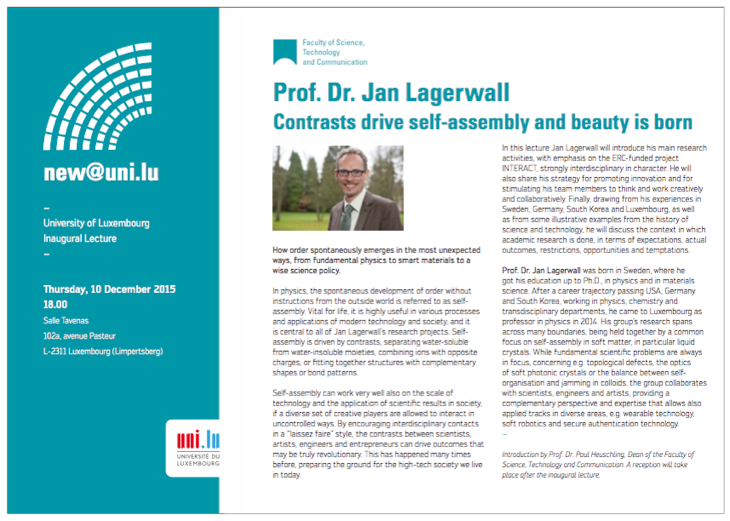
Tags: presentations
26/10/15 21:24
Congratulations to JungHyun and Kevin! During Kevin's bachelor thesis work (supervised by JungHyun) they discovered a very surprising textural change during the nematic-isotropic transition of liquid crystal shells. This became the start of a detailed investigation of what the substances that surround liquid crystal shells, typically surfactants and random coil polymers dissolved in aqueous mixtures, actually do to the liquid crystal. Now this study has been accepted for publication as a Communication in
Soft Matter.
You can download the 'just accepted' version here, and you will then see that water actually enters the liquid crystal, affecting its clearing point, and surfactant can go through from one side to the other, turning a hybrid shell uniformly homeotropic after some time. On the other hand, if the surfactant concentration is too low, the alignment is planar, because then the planar-aligning influence of water dominates. Polymers like PVA just stabilize the shells, they don't affect the alignment.
Tags: publications
14/10/15 01:44
On the 14th of October 2015 we had the unusual pleasure to welcome
two new group members on the same day, Venkatasubbarao (we call him just 'Rao') Jampani (left) and Larry Honaker (right). Rao is a post-doc working within the INTERACT project, focusing primarily on soft robotics based on liquid crystal elastomers with non-standard morphologies and topologies, and Larry is a Ph.D. candidate, working within his own AFR project LIMEFLOW, which deals with flow of liquid metals, in particular the possibility of achieving liquid metal jets co-flowing within polymer solutions.
Tags: Group, post-docs
15/09/15 01:43
We have the pleasure to welcome Vanessa Schmidt-Barbé as new secretary at our Research Unit, working primarily within Jan's ERC project INTERACT.
Tags: Group
05/08/15 08:11
Congratulations to YooMee, whose M.Sc. research on the preparation of multiresponsive fibers, by electrospinning dual-core fibers with different liquid crystals next to each other, is now on-line at
Journal of Materials Chemistry C. The paper, published in collaboration with Prof. Changsoon Kim at Seoul National University, describes the possibilities opened by incorporating multiple liquid crystals in one and the same fiber, giving a single fiber multiple functions (like selective reflection and birefringence, as in the bottom right pane of the ToC graphic, reproduced here). Apart from the feat of producing the fibers, YooMee gives two messages of great practical importance concerning liquid crystal electrospinning. First, she confirms the
recent observation in a paper with DaeKyom as lead author, that electrospun core-sheath fibers must not be collected on hydrophilic substrates like ordinary glass or silicon chips, because then capillary forces from condensed water will deform the fibers. In YooMee's case, she found that the phenomenon even leads to mixing of the adjacent cores. Second, while ionic surfactants are a useful additive to the polymer solution in solid fiber spinning, since they increase the conductivity and reduce the surface tension, they are a bad choice when the fiber contains a liquid crystal core. YooMee found dramatic reductions in clearing point of the encapsulated liquid crystal whenever the polymer sheath solution contained surfactant, indicating that the surfactant actually enters the liquid crystal and disturbs its order.
Download her paper at Journal of Materials Chemistry C!Tags: publications
01/07/15 22:32
It is our great pleasure to welcome Yong Geng to our group as a post-doc. After obtaining his Ph.D. with Prof. Maria Helena Godinho in Lisbon he worked as a post-doc with Prof. Ralf Stannarius and Dr. Alexey Eremin in Magdeburg, before he came to Luxembourg. He will be working on colloidal crystals of cholesteric shells, produced in a microfluidic set-up, focusing on the optical properties and the pattern formation of these systems. This research is the core of the interdisciplinary dual-PI project UNIQUE, funded by University of Luxembourg. The second partner of the project is the team around Gabriele Lenzini and Peter Ryan at the UL's Interdisciplinary Center for Security and Trust, which will analyze the patterns generated by the colloids from an information content point of view. Young will thus interact closely with Samir Ouchani, a post-doc in computer science working under the guidance of Gabriele.
Tags: Group, post-docs
14/06/15 22:57
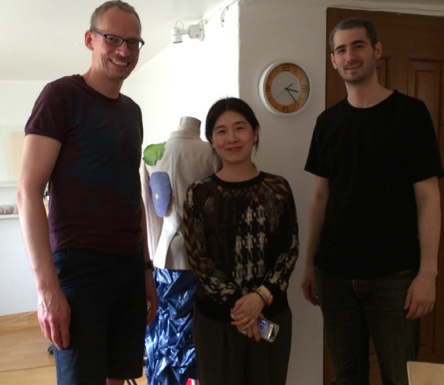
In connection to Jan's trip to Korea for YooMee's defense, he took the opportunity to visit wearable technology artist Younghui Kim (Hongik University) and robotics artist/designer Mathew Schwartz (Advanced Institute of Convergence Technologies) to discuss their collaboration within the framework of Jan's ERC project INTERACT. Here the three are gathered in Younghui's fantastic studio in Seoul, surrounded by her artwork.
Tags: collaborations, projects
